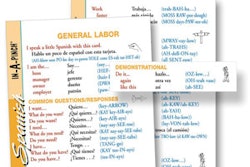
Managing employees really shouldn't be as hard as it is. For the most part, employees are pretty predictable.
- They are going to adjust their behavior to fit in with their co-workers.
- Left to themselves, they will do the things they like to do and avoid doing the things they don't like to do.
- They will do whatever they can to avoid pain.
- They will complain about being underpaid.
Having the right approach simplifies things and I'm going to show you one approach that works well.
Be forewarned, the model I'm about to share does not fly well with human resource professionals. They tend to be paranoid about anything that could be interpreted as an employment contract and they feel that any model that is explicit about job responsibilities borders on an employment contract.
I've never gotten my arms around their logic. I come from a simple world and believe employee management should be kept as simple as possible. Intentionally doing something that opens the door to confusion and miscommunication strikes me as stupid.
Here is the 9 step model for creating a self-managing worker.
1. Define Roles & Responsibilities
The goal of step one is to come up with a clear set of TASKS that the employee is to perform. Group these tasks by roles and responsibilities.
For example, a journeyman electrician has several responsibilities among which are installing the work properly; being productive; and training apprentices.
Those three things can be grouped into two roles:
ELECTRICIAN and TRAINER.
Examples of ELECTRICIAN tasks would be familiarizing himself with the plans and specs, planning out his work, and installing his materials.
Step 1 Activity: List all of the major tasks you need your workers to perform.
2. Set Standards & Expectations
Have you ever noticed how often employees are SHOCKED when told their performance was lagging? "I thought I was doing a good job? I didn't know you wanted it done like THAT?"
The problem is driven by misunderstanding, usually resulting from leaving them with hazy clarity about their job. Clear up the haziness. Don't allow for miscommunication about your expectations. Set clear performance standards for every task. How likely is someone to perform his job well if he doesn't know how well he is to perform it? Not very likely...and you suffer for it.
You need is to develop a level of clarity where every employee can look back at the end of the day and KNOW whether they succeeded or not. In clear, specific terms.
Step 2 Activity: Document and explain how well each task is to be performed.
3. Provide Job Training
Unless you are the most profitable company around and willing to pay the highest wages and bonuses, you are going to have to hire and promote people who do not already possess the skills necessary to succeed in the job.
That means they are going to have to learn the skills while working for you. Don't put off training your employees. Sacrifice a little productivity for skill development. Burden your foremen with the responsibility of training their apprentices.
Job training is a classic example of delayed gratification. A little pain (slower crews and more rework) in the short term leads to big gains (faster crews, greater flexibility, lower labor costs, and a larger pool of potential workers) in the long run.
A Test & Balance contractor that's working on a job for me has a training meeting every Monday morning for its field people. The class is lead by their veteran field guy who helps everyone stay up to date on technology and prepared for the crazy situations they run into in the field where HVAC systems rarely are designed or installed correctly.
A field tech told me about their weekly training sessions and he thought it was really valuable to him. What are the odds he'll be leaving the firm any time soon?
Step 3 Activity: Arrange for skill development.
4. Provide Tools & Resources
This one is pretty simple but consistently abused. Why would you expect your employees to meet your performance expectations when they don't have the tools and information they need to do so?
Everyone pays lip service to this problem but few are committed to solving it. When your employees don't have the tools and information they need YOU lose. Productivity suffers. Quality suffers. Safety suffers. Motivation dies. Turnover rises (there goes all that training you did).
Step 4 Activity: Ask your employee whether he has everything he needs to do the job right, and then get it for him.
5. Tie Rewards to Job Performance
You must connect the dots for employees. Few employees understand how their job performance affects their pay.Stunning isn't it?
You never suffered from that problem, did you? You've always understood that if you didn't do what you needed to do, your bank account would suffer.News Flash: that insight is almost earth shattering to your average employee.
The best analogy I can come up with is the feeling most voters have. "My vote won't count." For many reasons, employees just don't believe superior job performance will impact their income.
That's the financial side. The emotional side is equally important. Here's what you need to point out: Everyone likes to feel successful. Everyone likes to feel like a winner.
When they perform their jobs up to your expectations, they know they've won and the company has won. That knowledge lifts their spirits. It makes them feel good about themselves. You've got to point this out to them. It is a tremendous side effect of a job well done.
Step 5 Activity: Explain how your employee benefits financially and emotionally from doing a good job.
6. Review Performance
We're at step 6 on our journey to creating the self- managing employee. Step 6 is where a cycle begins. Review performance - give feedback - determine whether they will ever get it.
Performance should be reviewed weekly. Reflect on how well the employee did that week. Ask around for co-worker perceptions. Make note of it. Record any actual data that is available (productivity, rework, attendance).
The more reliable your employee, the less energy you need to put into the review. Just note the big items. The less reliable the employee, pay close attention and take detailed notes. You will need them.
Step 6 Activity: Gather feedback on employee performance.
7. Give Feedback & Coach
When the time is right - usually governed by lack of acceptable performance - sit down with the employee and jointly go over your notes and perceptions. Ask him what lead him to make the decisions he made and do the things he did.
Discuss how he made his decisions about the use of time, the level of craftsmanship they feel is right, and his treatment of his fellow crew members.
Coach him on how to make each decision correctly (everything is a decision: "Do I keep working or take a smoke break?"). Coach him on how to perform their craft. Coach him on how to treat people.
Step 7 Activity: Explain your view of employee's performance and provide tips on how to improve it.
8. Verify Capacity & Potential
At some point in time one of two things will occur with each of your employees. He will either master his job or your feedback sessions will feel like you're caught in an unending series of reruns of your least favorite TV show.
If it's the latter, you need to take a step back and decide whether to re-assign the person or let him go. Those are your only two desirable options at that point.
Your third option is do nothing, but that's the option you must strive to avoid. If you're stuck with that option, you need to crank up your recruiting machine.
If your employee has mastered the job, you should start looking for signs that the employee has the potential and wiring to take on more responsibility.
If so, look for an opportunity to promote him and go back to step 1.
Step 8 Activity: Decide whether your employee will ever be able to perform the job without constant supervision, then take action.
9. Result: Self-Managing Worker
Congratulations! Now that your employee is self-managing, your work life just got a lot easier.
Step 9 Activity: Enjoy your freedom.
The Big Benefit
Creating a self-managing organization is a real breakthrough. It lets you devote more time to replacing bad clients with clients who are great to work with. That's when running a business really gets fun: good workers, good clients, big bank account.
If you are going to achieve financial freedom, you have to start by creating freedom from the daily headaches of micro-managing your employees. Here is what you are really shooting for: creation of a culture where you don't have to spend a lot of time managing your people.



















